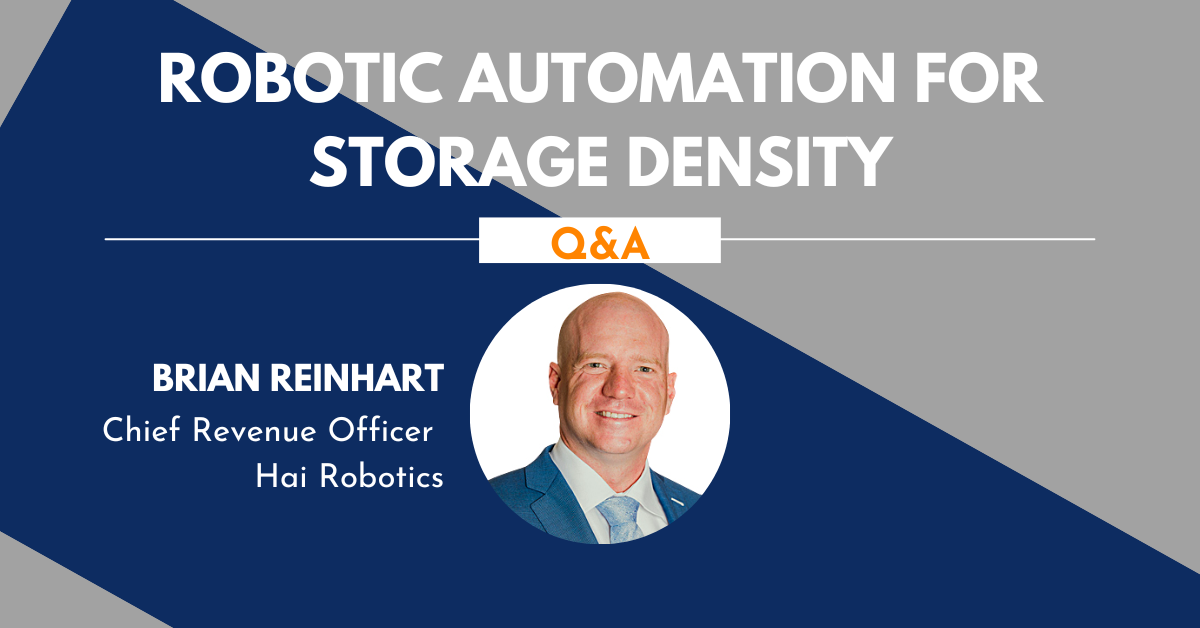


In a recent interview, we talked warehouse automation with Brian Reinhart from Hai Robotics to find out how warehouse robots are improving storage density and operations as a whole. Read on for his insights into the industry and how bots are affecting day-to-day operations in large warehouses around the world.
Hai Robotics is a leading global provider of Automated Storage and Retrieval Systems (ASRS), driven by our pioneering Autonomous Case-handling Robotic (ACR) technology. We engineer robotic solutions that optimize inventory storage and picking operations for warehousing, distribution, and manufacturing facilities. We currently have over 8,000 robots in operation, serving more than 1,000 customer sites across 30 countries.
As the Chief Revenue Officer, my main focus is expanding and growing our presence in the U.S. market. I joined the company in 2022 and have enjoyed building partnerships, assembling teams, and onboarding new and exciting customers.
Storage density, in essence, involves maximizing the amount of “stuff” in a given space. More technically, it measures how many storage locations can fit within a specific square footage.
One of the most effective ways to boost storage density is by tapping into unused vertical space. Advanced robotic solutions can maximize vertical storage by reaching heights over seven times that of an average person, enabling companies to achieve more dense and efficient operations within less space and reducing the need for expansive warehouses. For instance, HaiPick Systems can shrink a facility’s storage footprint by up to 75% — minimizing the need for network expansions and cutting real estate costs.
Industries like retail, consumer goods, apparel/footwear, manufacturing, grocery, food and beverage, and nearly any ecommerce or omnichannel operation can achieve significant gains through a goods-to-person system.
The beauty of these systems is that they are versatile and can benefit various industries and operations. High-volume, multi-shift operations are typically the easiest to justify from a cost/ROI perspective, but any labor-intensive operation can see improvements.
For end users, the CRN means several things. First, GreyOrange has thoroughly vetted and evaluated Hai Robotics against other competitors and alternative manufacturers. GreyOrange has exceptionally high standards regarding company infrastructure, manufacturing processes, quality, and support. End users can rest assured that GreyOrange has done much of the pre-qualification for them.
Second, it ensures that Hai Robotics and GreyOrange are consistently and proactively improving our partnership, technology connectivity, efficiency, and field performance while aligning our service and support. Being part of the network eliminates unknowns and reduces risk.
Most importantly, we ensure that the end user gets the best that both organizations have to offer. By partnering with GreyOrange and Hai Robotics, there are multiple points of accountability, with all parties focused on the end users’ success.
GreyMatter is an extremely smart, clean, user-friendly, and mature product. GreyOrange has done a fantastic job of implementing GreyMatter at scale, increasing performance and reliability while adding new manufacturers and technologies to its scope of responsibility. GreyMatter is easily and seamlessly integrated with Hai Robotics hardware, ensuring real-time accuracy, reporting, system monitoring, and performance within the tech stack.
A zero-walk, goods-to-person solution by GreyOrange and Hai Robotics is up to four times more efficient than a manual or walking fulfillment operation. This means a stationary operator at a goods-to-person workstation can pick up to four times more lines per hour than they could even with walking-assisted technologies like Autonomous Mobile Robots (AMRs) or Automated Guided Vehicles (AGVs).
Ultimately, zero-walk solutions such as ASRS significantly reduce the labor burden that many facilities face — cutting labor costs up to 67%. For operators, it’s less physically demanding and more ergonomic, allowing individuals to work comfortably and safely.
Buyer behavior is ever-changing, and companies need to adjust their go-to-market methods frequently. If the fulfillment and distribution networks behind those strategies are rigid, cash-intensive, or difficult to scale, it hinders a company’s ability to adapt. Flexible systems can scale up or down seasonally or long-term as business needs change — turning the distribution network into a value creator rather than a burden.
RELATED READ: Expert Q&A: Stacey Connors, InDro Robotics
The “dark warehouse” or operator-less environment is the goal for many, but there are still significant maintenance and reliability hurdles to overcome before that becomes a reality. In the short term, we’ll continue to see efficiency improvements that reduce labor burdens and storage enhancements that minimize space requirements.
As the market matures and scales, costs will decrease, lowering the entry point for more end users to adopt automation. Hai Robotics, supported by industry-leading partners like GreyOrange, will continue to deliver innovative and effective solutions that enhance efficiency, reduce costs, and meet the dynamic needs of modern warehouse operations.